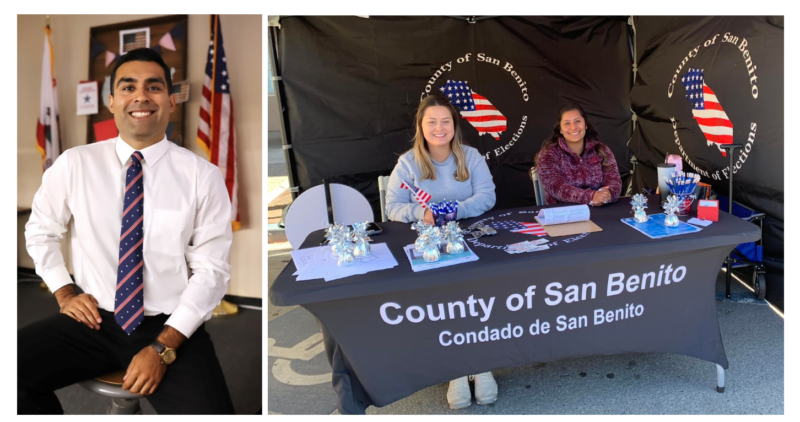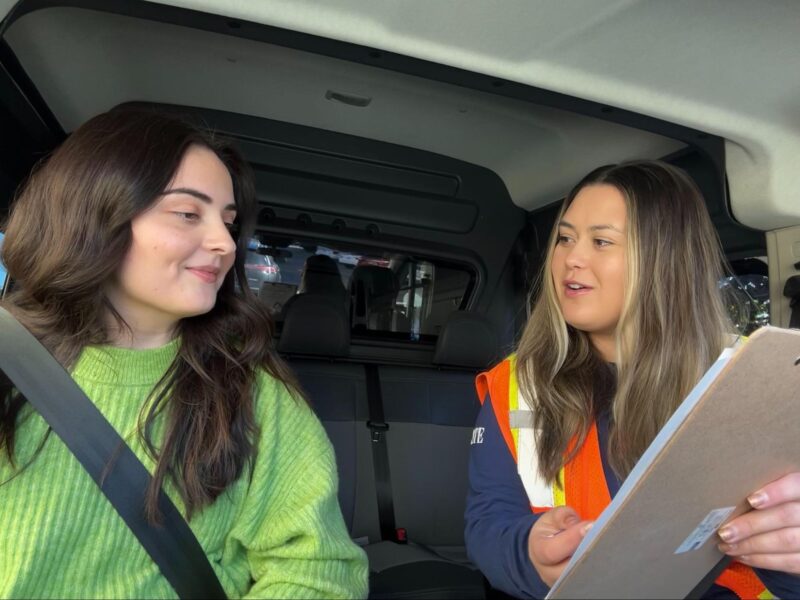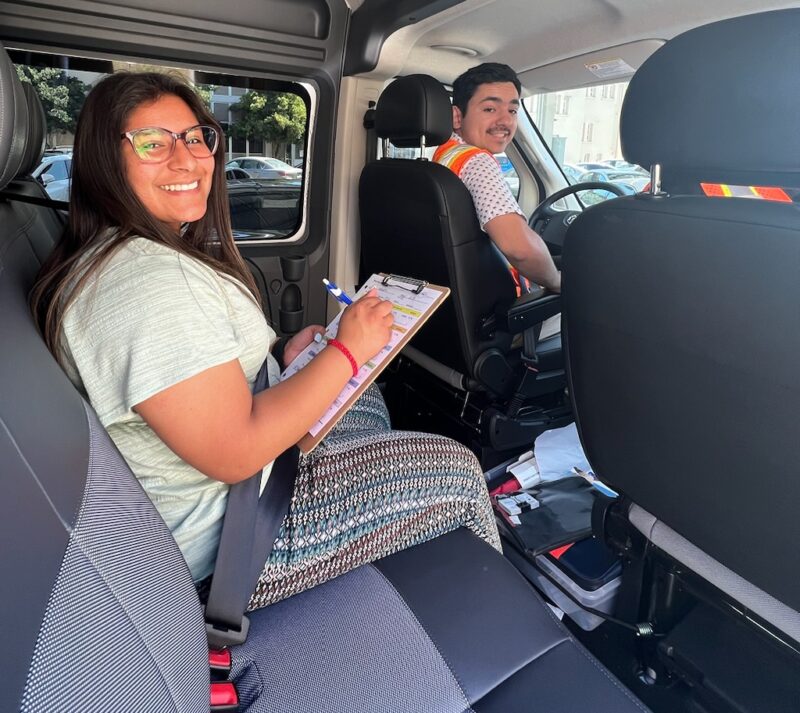San Benito County, California Creates a Ride Along Program
This article was featured in our ELECTricity newsletter in April 2023. Sign up to receive more success stories from election offices across the country.
In recent years, increasing transparency and gaining voter trust have become crucial efforts to add to the seemingly never-ending list of election officials’ duties. In San Benito County, California, Registrar of Voters Francisco Diaz created a program that makes improved transparency a walk in the park—or rather, a ride in a car.
San Benito County, California is a small agricultural community less than 50 miles south of San Jose, home to about 38,000 registered voters. Francisco and the Elections Coordinator, Cheyenne Wiles, are part of a young, creative, and engaged team of four dedicated to customer service.

Right photo: Elections Coordinator Cheyenne Wiles and Elections Associate Fatima Perez
Increasing Transparency: Taking Inspiration from the Police Department
San Benito County voters are unique in that prior to the pandemic, they already preferred casting mail ballots, with about 80% of them choosing that option. Now, that number is closer to 93%. With such a significant portion of voters voting absentee—and many of them utilizing drop boxes to return their ballots—it was important to Francisco to make the process as transparent as possible. “We need to bring people into our world,” says Francisco. “It’s not enough to provide policies and procedures or fact sheets. The public wants to participate in the process. They want to touch, feel, and see what it is that we do.” It turns out that creating a Ride Along program was a great way to achieve this.
Ride Along programs typically exist in police departments, where citizens can ride with a police officer for a day in their patrol car. Participants have the opportunity to observe the officer while they’re on duty, ask questions, and learn about their responsibilities. Shortly after Francisco became the Assistant Registrar in August of 2020, he read an article about how such programs can increase public confidence, and humanize the people doing critical work in our society. That’s when he had the idea to replicate something similar in his election office to increase the transparency around absentee ballots. His team quickly got to work creating a program that allowed participants to ride along with election workers as they collected ballots from drop boxes and brought them back to the election office to be processed.

Setting Up the Ride Along Program
The election team’s first step was turning to the local police department for advice, since they already had a Ride Along program set up in the county. The sheriff emphasized the importance of providing an educational component for participants before they even stepped foot in the car. This instruction would not only frame the importance of the work, but would also help to immediately build rapport with participants by giving them a chance to ask questions right from the beginning.
Next, the Francisco’s team had multiple conversations with their HR manager, county counsel, and other experts to get buy-in and approval. After that, Francisco ironed out the vision for the program and trained them on their roles and responsibilities, including how to respond to anticipated questions from participants. By the time the Gubernatorial Recall election came around in September 2021, the team was ready to launch the pilot program.
The Pilot Program: How It Worked
For the first iteration of the Ride Along program, the San Benito County team invited a select group of community members to participate. They started with folks highly engaged in elections and politics, including a local Republican election integrity group. Francisco says they were excited to be part of the program.
When participants showed up, the elections team provided a classroom session about the vote by mail process, and what they could expect over the course of the day. Next, after signing waivers, participants got to meet the dropbox team, which is always a team of two people.
Then came the fun part. Participants rode along with the dropbox team to each of the county’s six drop boxes over the course of a three hour, highly structured trip. At each drop box, the election workers logged the arrival time, mileage, checked the drop box for signs of tampering or vandalism, opened the drop box, collected the ballots, placed them in a security pouch, and sealed it. Once they did so for all six drop boxes, they drove back to the election office where they returned the sealed pouches to the supervisor, and he checked their logs and made sure everything was in order.

Finally, Francisco invited participants to chat with him after they got back to the election office to address any lingering questions they may have had. These pre-and-post trip sessions took a bit of extra time, but Francisco thinks they’re key to building trust with participants.
Converting Skeptics Into Supporters
Over 30 participants were involved in the pilot phase of the project, and most of them came with preconceived notions about mail ballots, how they’re processed, and who works in elections. Many of them viewed the elections process as highly partisan. But over the course of the day, participants have plenty of time to ask questions and really get to know the people working at the election office. Francisco believes this relationship-building component is crucial. “We need to personalize elections,” he says. “Every city, county, and state is different, but the people that work in elections tend to be the same. We’re all passionate about what we do, we’re highly engaged, and we’re equally concerned about the election process and its integrity. And I think that is something that we need to show.”
In one instance, two participants came in highly skeptical of the elections process. But after chatting with an election worker, they learned that he was the grandson of one of their friends. “That connection was key,” says Francisco. “The following day, they came back and brought cupcakes for the entire team. For the following election, they decided to volunteer as poll workers.” One day’s worth of work helped transform some of the county’s harshest critics into their most fervent supporters.

“If at the end of this, if we can get [participants] to have confidence in our local elections office and the local elections team, that’s a win for us,” says Francisco. “Because next time they’re at the supermarket and they’re having a conversation, they’ll at least be able to say that in San Benito County we’re doing it correctly.”
Plans for Expanding the Program
The pilot program was so successful that Francisco and his team are anticipating increased interest in the future, especially with the upcoming presidential election. They’ve since opened up the program to any San Benito County resident. Prior to their next election in March 2024, they plan to invite anyone who’s interested to participate, even citizens in surrounding counties.
But they are currently limited to the small space they have in their vehicle, which can only hold two participants at a time. Francisco also recognizes that not everyone can afford to spend hours riding along with election workers to collect ballots. So they’re thinking about recording future sessions, and posting them online so that anyone can get a glimpse into their work from the comfort of their own homes, at a time that’s convenient for them.
If you’re interested in setting up a similar program in your election office, Francisco recommends speaking with other departments and even neighboring counties to get their feedback and advice. It can be a long process to set something like this up, and Francisco and Cheyenne are willing to help guide you through it. They can be reached at [email protected].